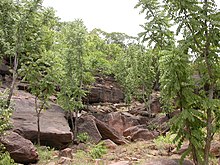| Pericopsis laxiflora | |
|---|---|

| |
| Scientific classification | |
| Kingdom: | Plantae |
| Clade: | Tracheophytes |
| Clade: | Angiosperms |
| Clade: | Eudicots |
| Clade: | Rosids |
| Order: | Fabales |
| Family: | Fabaceae |
| Subfamily: | Faboideae |
| Genus: | Pericopsis |
| Species: | P. laxiflora
|
| Binomial name | |
| Pericopsis laxiflora (Benth. ex Baker) Meeuwen
| |
Pericopsis laxiflora is a woody deciduous shrub or tree within the Fabaceae family. Sold commercially as satin wood,[1] it is known in some regions as Kulu Kulu,[2] among the Hausa speaking people, it is called Makarfo, the Yorubas call it Ayan and the Igbos call it Abua-Ocha.[3] It is one of three species in the genus Pericopsis genus that occurs in Africa.
The species contains the alkaloids: N-methylcytisine, ammodendrine, and choline.[4]
- ^ Fitzgerald, Maurice A.; Gunning, Peter J. M.; Donnelly, Dervilla M. X. (1976). "Phytochemical examination of Pericopsis species". Journal of the Chemical Society, Perkin Transactions 1 (2): 186–191. doi:10.1039/p19760000186. ISSN 0300-922X.
- ^ Tringali, Corrado (1995). "Identification of bioactive metabolites from the bark ofPericopsis (Afrormosia) laxiflora". Phytochemical Analysis. 6 (6): 289–291. doi:10.1002/pca.2800060603.
- ^ Fadipe, L. A.; Babayi, H.; Anselm, O. A. (2019-12-14). "Isolation and in-vitro assessment of two indole alkaloids from Pericopsis laxiflora leaf extract for their antibacterial potentials". Journal of Chemical Society of Nigeria. 44 (7). ISSN 0795-2066.
- ^ Forestieri, A. M.; Monforte, M. T.; Ragusa, S.; Trovato, A.; Iauk, L. (1996). "Antiinflammatory, Analgesic and Antipyretic Activity in Rodents of Plant Extracts used in African Medicine". Phytotherapy Research. 10 (2): 100–106. doi:10.1002/(SICI)1099-1573(199603)10:2<100::AID-PTR724>3.0.CO;2-I. ISSN 1099-1573. S2CID 84307919.